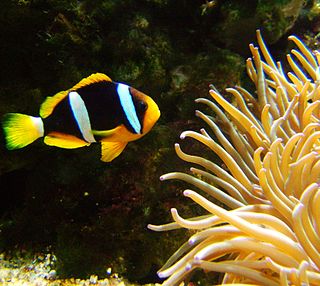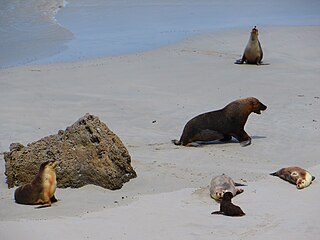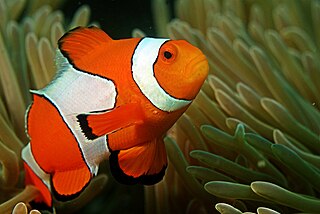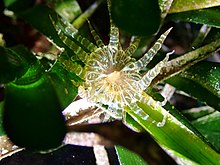
Clownfish or anemonefish are fishes from the subfamily Amphiprioninae in the family Pomacentridae. Thirty species of clownfish are recognized: one in the genus Premnas, while the remaining are in the genus Amphiprion. In the wild, they all form symbiotic mutualisms with sea anemones. Depending on the species, anemonefish are overall yellow, orange, or a reddish or blackish color, and many show white bars or patches. The largest can reach a length of 17 cm, while the smallest barely achieve 7–8 cm.

The grey heron is a long-legged wading bird of the heron family, Ardeidae, native throughout temperate Europe and Asia, and also parts of Africa. It is resident in much of its range, but some populations from the more northern parts migrate southwards in autumn. A bird of wetland areas, it can be seen around lakes, rivers, ponds, marshes and on the sea coast. It feeds mostly on aquatic creatures which it catches after standing stationary beside or in the water, or stalking its prey through the shallows.

Anthozoa is a subphylum of marine invertebrates which includes sessile cnidarians such as the sea anemones, stony corals, soft corals and sea pens. Adult anthozoans are almost all attached to the seabed, while their larvae can disperse as planktons. The basic unit of the adult is the polyp; this consists of a cylindrical column topped by a disc with a central mouth surrounded by tentacles. Sea anemones are mostly solitary, but the majority of corals are colonial, being formed by the budding of new polyps from an original, founding individual. Colonies are strengthened by calcium carbonate and other materials and take various massive, plate-like, bushy or leafy forms.

Clark's anemonefish, also known as the yellowtail clownfish, is a marine fish belonging to the family Pomacentridae, the clownfishes and damselfishes.

The Australian sea lion, also known as the Australian sea-lion or Australian sealion, is a species of sea lion that is the only endemic pinniped in Australia. It is currently monotypic in the genus Neophoca, with the extinct Pleistocene New Zealand sea lion Neophoca palatina the only known congener. With a population estimated at 14,730 animals, the Wildlife Conservation Act of Western Australia (1950) has listed them as "in need of special protection". Their Conservation status is listed as endangered. These pinnipeds are specifically known for their abnormal breeding cycles, which are varied between a 5-month breeding cycle and a 17-18 month aseasonal breeding cycle, compared to other pinnipeds which fit into a 12-month reproductive cycle. Females are either silver or fawn with a cream underbelly and males are dark brown with a yellow mane and are bigger than the females.

A tide pool or rock pool is a shallow pool of seawater that forms on the rocky intertidal shore. These pools typically range from a few inches to a few feet deep and a few feet across. Many of these pools exist as separate bodies of water only at low tide, as seawater gets trapped when the tide recedes. Tides are caused by the gravitational pull of the sun and moon. A tidal cycle is usually about 25 hours and consists of one or two high tides and two low tides.

Actiniidae is the largest family of sea anemones, to which most common, temperate, shore species belong. Most members of this family do not participate in symbioses with fishes. Three exceptions are the bubble-tip anemone, snakelocks anemone and Urticina piscivora.

The ocellaris clownfish, also known as the false percula clownfish or common clownfish, is a marine fish belonging to the family Pomacentridae, which includes clownfishes and damselfishes. Amphiprion ocellaris are found in different colors, depending on where they are located. For example, black Amphiprion ocellaris with white bands can be found near northern Australia, Southeast Asia, and Japan. Orange or red-brown Amphiprion ocellaris also exist with three similar white bands on the body and head. Amphiprion ocellaris can be distinguished from other Amphiprion species based on the number of pectoral rays and dorsal spines. Amphiprion ocellaris are known to grow about 11 cm long. Like many other fish species, females are, however, larger than males. The life cycle of Amphiprion ocellaris varies in whether they reside at the surface or bottom of the ocean. When they initially hatch, they reside near the surface. However, when Amphiprion ocellaris enter into the juvenile stage of life, they travel down to the bottom to find shelter in a host anemone. Once they find their anemone, they form a symbiotic relationship with them.

Bubble-tip anemone is a species of sea anemone in the family Actiniidae. Like several anemone species, E. quadricolor can support several anemonefish species, and displays two growth types based on where they live in the water column, one of which gives it the common name, due to the bulbous tips on its tentacles.

Hexacorallia is a class of Anthozoa comprising approximately 4,300 species of aquatic organisms formed of polyps, generally with 6-fold symmetry. It includes all of the stony corals, most of which are colonial and reef-forming, as well as all sea anemones, and zoanthids, arranged within five extant orders. The hexacorallia are distinguished from another class of Anthozoa, Octocorallia, in having six or fewer axes of symmetry in their body structure; the tentacles are simple and unbranched and normally number more than eight. These organisms are formed of individual soft polyps which in some species live in colonies and can secrete a calcite skeleton. As with all Cnidarians, these organisms have a complex life cycle including a motile planktonic phase and a later characteristic sessile phase. Hexacorallia also include the significant extinct order of rugose corals.

The Red Sea Clownfish, commonly known as the Red Sea or two-bandedanemonefish is a marine fish belonging to the family Pomacentridae, the clownfishes and damselfishes. Like other species of the genus, the fish feeds on algae and zooplankton in the wild.

The snakelocks anemone is a sea anemone found in the eastern Atlantic Ocean and the Mediterranean Sea. The latter population is however sometimes considered a separate species, the Mediterranean Snakelocks anemone.

Sea anemones are a group of predatory marine invertebrates constituting the order Actiniaria. Because of their colourful appearance, they are named after the Anemone, a terrestrial flowering plant. Sea anemones are classified in the phylum Cnidaria, class Anthozoa, subclass Hexacorallia. As cnidarians, sea anemones are related to corals, jellyfish, tube-dwelling anemones, and Hydra. Unlike jellyfish, sea anemones do not have a medusa stage in their life cycle.

Anemonia is a genus of sea anemones belonging to the family Actiniidae.

The Enthemonae is a suborder of sea anemones in the order Actiniaria. It comprises those sea anemones with typical arrangement of mesenteries for actiniarians.

Actinostola callosa is a species of sea anemones in the family Actinostolidae in the order Actiniaria. It is a deep sea species and occurs in both Pacific and Atlantic Oceans from the continental shelf to abyssal depths.

Gonactinia is a monotypic genus of sea anemones, and G. prolifera is the only species in the genus. It is sometimes called the storey anemone and is found on either side of the northern Atlantic Ocean.

Paranemonia cinerea is a sea anemone that inhabits the Mediterranean Sea. It primarily inhabits lagoons near the coast in the Adriatic Sea, and is known to inhabit the coasts of Albania, France, Greece, Italy, and Spain. Paranemonia cinerea was thought to be endemic to the Mediterranean, until it was discovered in the Ria de Arosa in 1992; though new discoveries are complicated by easy confusion with Anemonia sulcata.
Pagurus forbesii is a species of hermit crab in the family Paguridae. It is found in the northeastern Atlantic Ocean and the Mediterranean Sea.
Edwardsia timida, also known as the timid burrowing anemone, is a species of sea anemone in the family Edwardsiidae.


















